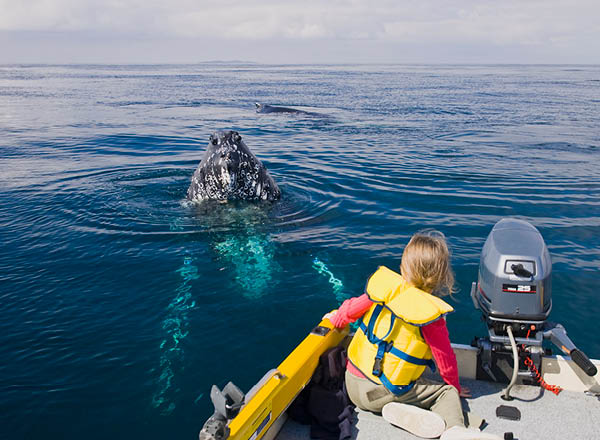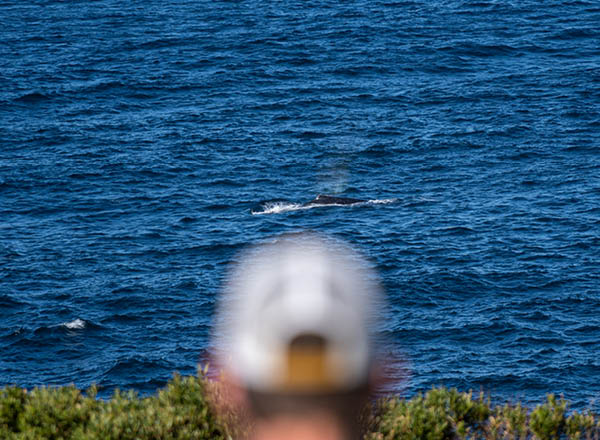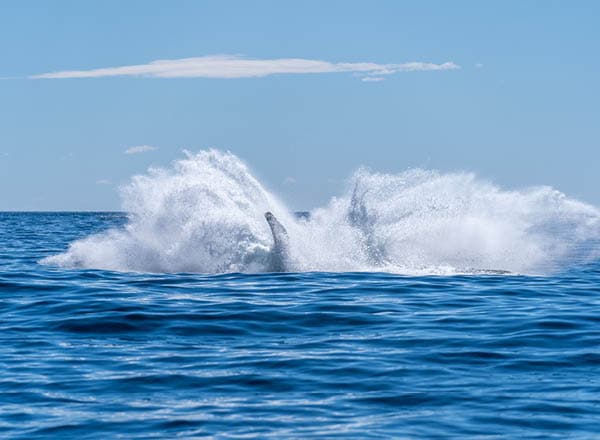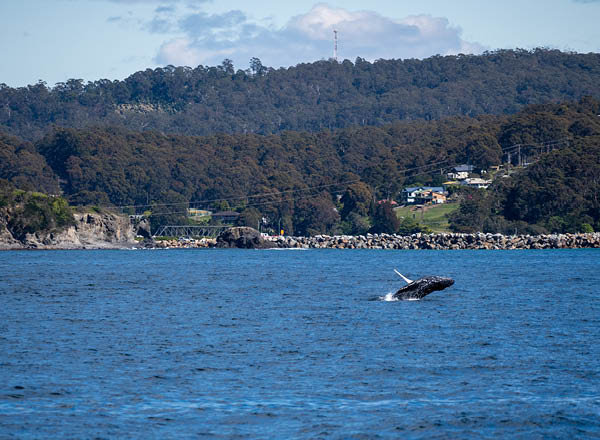Longing to find out if you can tell a playful Humpback from a Southern Right? Eurobodalla is the right place to put your knowledge to the test: 30,000 whales make their way up the local coastline each winter (June/July is the winter peak) before travelling back down in spring as part of an annual whale migration (September to November is spring peak).

As the pods, mothers and calves stick close to shore along this stretch of the coastline (it gives them a chance to rest), both seafarers and landlubbers have plenty of opportunities to spot these gigantic gentle creatures.
The key to spotting whales from land is to find an area offering an elevated view of the sea. Luckily, across Eurobodalla the regions cliffs, headlands and lookouts provide myriad excellent vantage points.
As for telling those whale species apart? Here are two tips to get you started: unlike the Humpback, the Southern Right has no dorsal fin, so keep your eyes glued for its back. Plus, the Southern Right pushes water out of not one but two blowholes in a ‘v’ shape. The Humpback? Its single blowhole creates one big, ‘bushy’ blow.
Who knew?

South Durras and surrounds
Beaches dot the edge of Murramarang National Park, bringing with it plenty of opportunities to access some of the Park’s best whale watching spots. At Myrtle Beach a short (600m) track through natural bushland ends on an isolated beach, perfect for a picnic while whale watching.
Nearby, the easy two-kilometre return Wasp Head walk not only offers whale watching opportunities and spectacular views down to the rocky cover of Wobbegong Bay, but it passes through a number of historic Aboriginal sites enroute. Richmond Beach and Dark Beach are two other options worth adding to your list, as is Emily Miller Beach.
Batemans Bay
Around Batemans Bay, the whales are so close that guests of local adventure operator Region X often spot them while out on a kayaking tour.

Back on land, South Head is a secluded headland with two small clearings, one to the north and one to the south. Both can be accessed via a short walk along paths at the end of Tallawang Avenue, Malua Bay. To get here from Batemans Bay drive south along George Bass Drive (the Coast Road) and turn left into Tallawang Avenue. There is limited street parking, but whales can be sighted as close as 150 metres from the headland.
Burrewarra Point Lookout at Guerilla Bay
Eighteen kilometres south of Batemans Bay, this lookout is a 20-50 minute easy walk from the beach carpark at Guerilla Bay. Be warned, you may be so engrossed in the breathtaking views up and down the coast that you forget to focus on potential whale sightings.
To find the lookout take the Guerilla Bay turnoff onto Burri Point Road. The track to the walk and lookout is signposted.

Broulee Island, Broulee
Although it’s an island by name, Broulee Island is joined to the mainland by a sandbar so it’s always accessible. Combine the hour-long walk around the island with a dash of whale watching – your chances of success at spotting them are high regardless of which side of the island you are on. Broulee Island is also a good place to see dolphins and, out of the water, a wonderful display of native plants and marine birdlife, including the superb fairy wren and white bellied sea eagle.
Toragy Point at Moruya Heads
Toragy Point has plenty to offer whale watchers: views north along the coast, interpretive signage about whales and marine life courtesy of National Parks, limited parking, some seating and an historic graveyard – all less than ten minutes out of Moruya. To get there, turn left off the Princes Highway just south of Moruya into South Head Road, drive toward the coast, and up around the headland.

Carters Beach Headland, Kianga
Just five kilometres north of Narooma, Carters Headland at the northern end of Bar Beach is a popular spot for dolphins to frolic. Come here for the surf, the views (180-degree views as far north as Pigeon House Mountain on a clear day) and the chance to see whale calves frolicking out past the rocks.
Narooma Golf Club, Narooma
In the krill-rich waters of this part of the coast, where the continental shelf dips closer to shore than almost anywhere else on Australia’s east coast, whales are easy to spot from shore. So easy, in fact, that children from Narooma Public School often watch them from the playground at recess, thanks to the school’s location on a grassy headland.
A round of golf at Narooma Golf Club or a meal at Paul’s on the Course can provide the same view: whales are even spotted by people from the top end of the club’s car park.

Bar Rock Road Lookout, Narooma
This great vantage point lies just two minutes from Narooma Town Wharf, below the historic Coastal Patrol Station (old harbourmaster’s residence) overlooking Narooma Bar.
The lookout features interpretive signs with cetacean identification (whales and dolphins) and timber stairs down to Australia Rock.
Montague Island, Narooma
One of the best-known whale watching spots in the region is accessed by sea. Nearby Montague Island, just nine kilometres from Narooma, is fantastic for whale watching, and large pods of whales are often seen off Montague.
The island is also famous for its seal population. A number of local operators offer boat trips to Montague Island, as well as whale watching tours.
